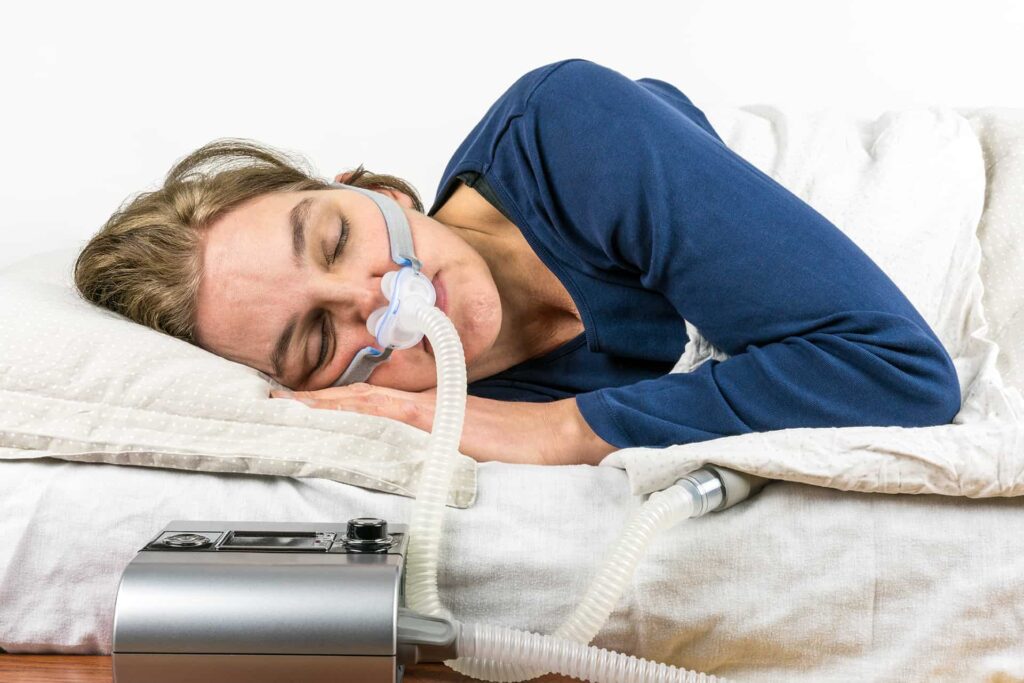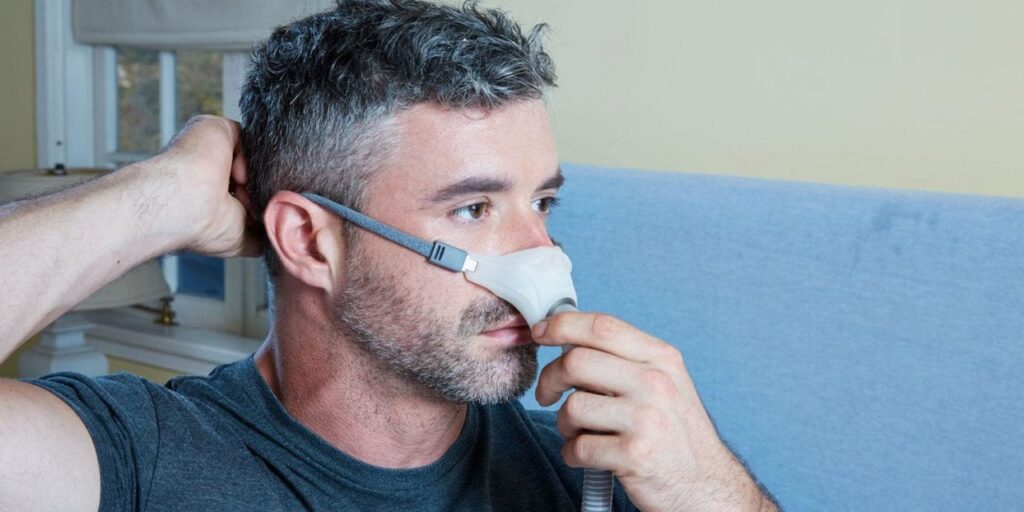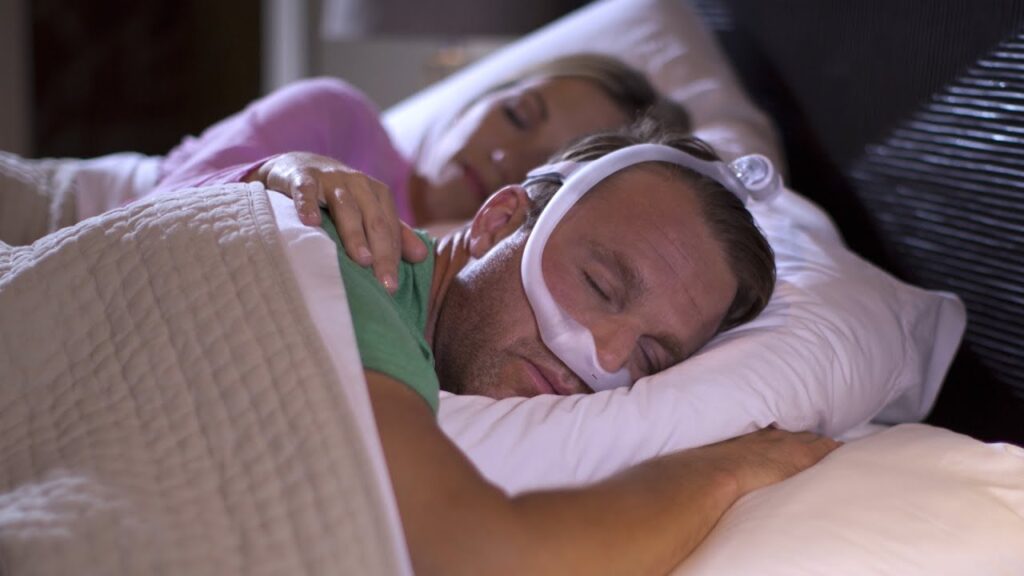Nasal CPAP masks have been associated with a clown nose design for decades. It fits snugly around the nasal cavity and across the bridge of the nose. This design featured tiny nasal buds that sat atop the nostrils to provide a snug fit. There’s a new hybrid look that fits snugly under the nostrils. Cradle-type CPAP masks are a hybrid between the standard nasal design and the pillow-style masks, allowing for a seal under the nose.
CPAP mask that rests comfortably over the nose, are often known as a nasal cpap mask.
Philips was the first to go market with these masks several years ago. This is no longer the case, as there are now viable alternatives available from a wide variety of other manufacturers. However, there are advantages and disadvantages to each option. This mask, the DreamWear Nasal Cradle, is available from Philips. ResMed features the N30i as well as the N30 cradle type. And then there’s Fisher & Paykel, with its Evora.
See also: Review and Maintenance of Evora Full Face CPAP Mask
All of these CPAP masks seal under the nose in a “cradle-style”, yet they all have substantial variances. Now, let’s delve even farther into each one.

Evora Nasal Cradle CPAP Mask
Fisher and Paykel have released a fantastic new mask. Fisher is superb when it comes to donning a mask. One of their specialities is producing some of our favourite things. While the Evora’s front-of-the-face tube connection is standard, the headgear and fit are anything but standard.
The mask can be easily put on and removed thanks to its “ball-cap” shape. You can choose from four different cushion sizes: small, medium, wide, and large. There is a lot of leeway in the standard, very adaptable headgear. Discuss the best and worst parts with me.
For Evora Pros:
- The “ball-cap” kind of cap is a great example of unusual headwear. Once you find the right fit, it’s as easy to put on and take off as a baseball cap. It also has a very lengthy lifespan.
- Good comfort and support; this cradle mask is exceptionally stable. The frame, the cushion, and the helmet all work together to keep the device firmly in place on the face.
- Cushions on the Evora are made of a soft, stretchable silicone. That way, it may utilise the air pressure from your CPAP machine to aid the seal. This creates a reliable seal without requiring excessive tightening of the fasteners.
- The frame and headpiece are unable to stay attached to the cushion and tend to dislodge quickly. This simplifies upkeep significantly.
Cons of Evora:
- Some users may find the hard plastic of the frame and headpiece to be irritating. Most notably if the Evora is overtightened.
- The cushion may be difficult to remove due to the secure clipping mechanism. This means that it won’t ever come off, but it is a bit of a pain to get on and off the frame when it has to be replaced or cleaned.
- Applying pressure to the upper lip may Some Evora owners have reported upper-lip pain after using the device. For most people, this was merely a matter of fit, but for others, it was a deal breaker.
Nasal Cradle CPAP Mask from DreamWear
The DreamWear CPAP mask was the first of its kind to become widely popular. A large reason why is because it worked quite well. Many CPAP users’ lives were transformed by its over-the-head tube connection.
The DreamWear Nasal frame is extremely adaptable, as it is compatible with the DreamWear Full and DreamWear Pillows. This mask cushion can be purchased in four different sizes: small, medium, large, and wide.
The DreamWear frame comes in three different sizes—small, medium, and large—while the helmet is one universal size. That makes this mask extremely adaptable. Now, I’d like to go over the benefits and drawbacks of the DreamWear Nasal in great detail.
Pros of the DreamWear Nasal Cradle:
- Connecting the tube to the CPAP mask at the top of the head frees CPAP users from having to lug it with them as they turn their head from side to side. Perfect for those who want to sleep on their sides.
- As an added bonus, if you have to get up in the middle of the night, you may quickly and conveniently connect and disconnect your tubing using the simple quick connect.
- The silicone nose pad is incredibly smooth and soft, making a snug fit. In doing so, you lessen the likelihood of skin contact problems including abrasion and irritation.
- Now that the CPAP mask comes standard with headgear arms, the headgear strap can rest lower on the back of the head. Thus, the strap is less likely to move up the back of the wearer’s head and disrupt the seal.
Cons of the DreamWear Nasal Cradle:
- This mask’s frame features tubing on the side of the face to direct airflow from the top of the device to the nose. The tubing may be too thick and irritating for some people. The mask comes with a soft cover to help with this. Some people also claim to be able to hear it slightly if the side tube is pinched off.
- The cradle’s front-facing exhalation port might be draughty and noisy.
- The DreamWear Nasal’s cradle is flatter than those of competing products, which may be an advantage for people who experience leaks at the side of their nose. Side-nasal leakage is a possible result of this.

The N30 Nasal Cradle CPAP Mask
As cradles go, ResMed’s N30 is one of the coolest options out there. Cradle mask benefits are combined with the various characteristics that make the P10 Nasal Pillow so well-liked. The N30 shares the same ultra-slim and flexible headpiece as the P10.
The mask’s tube connects to the facepiece, making for a more conventional feel. Pillows come in three different sizes: small, medium, and small-wide. You may adjust the helmet so that it fits snugly on your head.
N30 Pros:
- Comfortable headwear is easy to find with the N30, which has ultra-thin, elastic headgear. Because of this, putting it on and taking it off is a breeze, and it also fits snugly.
- Cushion’s side wings help the N30 form a tight seal, and the cradle’s depth makes for a comfortable wear. For those who have had leakage to the sides of their nose with alternative cradles, this is the solution.
- Very soft and dispersed breath out; hardly any wind is created when you exhale. That implies the exhalation won’t be audible or noticeable to your sleeping companion.
- Without using any fasteners or gimmicks, the cushion can be easily removed. The cushion simply slides on and off the frame, but only in one direction. Easy to understand.
N30 Cons:
- The N30’s headgear is notoriously finicky, so be sure to remove it before servicing the bike. The way it fastens makes it quite challenging to remove. It’s also simple to wear backwards.
- Although headgear tends to wear out rapidly, its stretchy material ensures a snug but pleasant fit. This advantage, however, becomes a minor disadvantage as the material loses its stretch. You can buy new headgear when it wears out, but you should do so more frequently than with some types of gear.
- You can’t just take off the mask and leave the tubing connected because there isn’t a quick-connect feature. Since this CPAP mask is so simple to put on, it’s possible that this won’t be an issue for you, but it’s worth noting that most others do have this capability.

